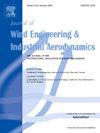A novel nested BO-LM-BPNN method for wind pressure field prediction of non-isolated low-rise buildings
IF 4.9
2区 工程技术
Q1 ENGINEERING, CIVIL
Journal of Wind Engineering and Industrial Aerodynamics
Pub Date : 2025-02-17
DOI:10.1016/j.jweia.2025.106047
引用次数: 0
Abstract
The prediction of wind pressure field of non-isolated low-rise building is a prerequisite for the wind-resistant design of building structures. Due to the powerful performance of physical wind tunnel tests and computational fluid dynamic simulations, they have been widely used to directly obtain and predict the wind pressure field of non-isolated low-rise buildings. However, these two methods are susceptible to the economy and time cost constraints respectively. Moreover, because non-isolated low-rise buildings usually have complex surrounding environments, it is difficult for these two methods to obtain the wind pressure fields under all complex working conditions. In this study, a nested Bayesian optimization (BO)-Levenberg Marquardt (LM)-backpropagation neural network (BPNN) method is proposed. Firstly, based on the measured wind pressure field data under some representative working conditions, the conversion relationship between multi-input and single-output of wind pressure field using BPNN model is derived. Then, the hyperparameters and trainable parameters in BPNN model are optimized by BO and LM algorithms respectively. Finally, a nested input structure is established to further improve the accuracy of high-order moments and peak values of wind pressure field. Numerical results show the proposed method has high accuracy in the prediction of the wind pressure field of non-isolated low-rise buildings. The nested input structure can further improve the prediction accuracy of high-order moments and peak values in hazardous areas of roof. Therefore, the research results can serve as a reference for studies on wind pressure fields and wind loads of non-isolated low-rise buildings.
非隔震低层建筑风压场预测的巢式BO-LM-BPNN方法
非隔震低层建筑的风压场预测是进行建筑结构抗风设计的前提。由于物理风洞试验和计算流体力学模拟的强大性能,它们已被广泛用于直接获取和预测非隔震低层建筑的风压场。然而,这两种方法分别受到经济和时间成本的限制。此外,由于非隔震低层建筑通常具有复杂的周围环境,这两种方法难以获得所有复杂工况下的风压场。本文提出了一种嵌套贝叶斯优化(BO)-Levenberg Marquardt (LM)-反向传播神经网络(BPNN)方法。首先,基于典型工况下实测的风压场数据,利用BPNN模型推导了多输入单输出风压场的转换关系;然后,分别采用BO和LM算法对BPNN模型中的超参数和可训练参数进行优化。最后,建立了嵌套输入结构,进一步提高了风压场高阶矩和峰值的精度。数值计算结果表明,该方法对非隔震低层建筑的风压场预测具有较高的精度。嵌套输入结构可以进一步提高顶板危险区域高阶矩和峰值的预测精度。因此,研究结果可为非隔震低层建筑的风压场及风荷载研究提供参考。
本文章由计算机程序翻译,如有差异,请以英文原文为准。
求助全文
约1分钟内获得全文
求助全文
来源期刊
CiteScore
8.90
自引率
22.90%
发文量
306
审稿时长
4.4 months
期刊介绍:
The objective of the journal is to provide a means for the publication and interchange of information, on an international basis, on all those aspects of wind engineering that are included in the activities of the International Association for Wind Engineering http://www.iawe.org/. These are: social and economic impact of wind effects; wind characteristics and structure, local wind environments, wind loads and structural response, diffusion, pollutant dispersion and matter transport, wind effects on building heat loss and ventilation, wind effects on transport systems, aerodynamic aspects of wind energy generation, and codification of wind effects.
Papers on these subjects describing full-scale measurements, wind-tunnel simulation studies, computational or theoretical methods are published, as well as papers dealing with the development of techniques and apparatus for wind engineering experiments.

 求助内容:
求助内容: 应助结果提醒方式:
应助结果提醒方式:


